Seismo-Hydrogeodynamic Effects in Groundwater Pressure Changes: A Case Study of the YuZ-5 Well on the Kamchatka Peninsula
Abstract
:1. Introduction
- (1)
- Limited manifestation of HPs and CSEs over an area due to their confinement to relatively small areas near earthquake sources, where observation wells may be absent;
- (2)
- Using shallow wells for long-term observations, penetrating unconfined or partially confined aquifers in loose Quaternary deposits or in weathered crystalline rocks without assumptions on static confined conditions and quasi-elastic groundwater pressure response to barometric, tidal and seismic influences [19];
- (3)
- Lack of long-term precision observations of groundwater pressure variations in confined aquifers at depths of at least hundreds of meters in the near and intermediate field zones of earthquake sources.
| No. | Hypocenter | Mw | Epicentral Distance, de, km/ Hypo- central Distance, dh, km | Shaking Intensity on the MSK-64 Scale | Amplitude of the Coseismic Water Level/ Pressure Fluctuation ***, Δh, cm/hPa | Volumetric Coseismic Deformation in the Well YuZ-5 area, 10−9 | ||||||
|---|---|---|---|---|---|---|---|---|---|---|---|---|
| Date dd.mm.yyyy | Time hh:mm | Coordinates, degrees | H, km | |||||||||
| N | E | By Coseismic Level Fluctuation, D1 **** | By the Dislocation Model [30] | Reference | ||||||||
| 1 | 05.12.1997 * | 11:27 | 54.0 ** | 162.3 ** | 10 | 7.8 | 200 **/200 ** | 5–6 | −12.0 | 75 | 48 | [16] |
| 2 | 01.06.1998 | 05:34 | 52.81 | 160.37 | 31 | 6.4 | 136/140 | 3–4 | −1.0 | +6.3 | +7.9 | |
| 3 | 08.03.1999 | 12:26 | 51.93 | 159.72 | 7 | 6.9 | 162/162 | 5 | −1.7 | +10.6 | +31 | |
| 4 | 20.12.2000 | 09:20 | 53.31 | 160.06 | 66 | 5.4 | 110/128 | 4 | +0.6 | −3.8 | −0.3 | |
| 5 | 16.06.2003 | 22:08 | 55.30 | 160.34 | 190 | 6.9 | 266/327 | 2–3 | −0.3 | +1.9 | +0.7 | |
| 6 | 20.03.2004 | 08:53 | 53.74 | 160.76 | 40 | 5.6 | 167/171 | 4–5 | +0.25 | −1.6 | −0.02 | |
| 7 | 05.07.2008 | 02:12 | 53.45 | 154.93 | 633 | 7.7 | 232/674 | 3–4 | +0.3 | −1.9 | −7.3 | ***** |
| 8 | 24.11.2008 | 09:02 | 53.77 | 154.69 | 564 | 7.3 | 253/618 | 3 | +0.2 | −1.2 | −3.7 | ***** |
| 9 | 28.02.2013 | 14:06 | 50.67 | 157.77 | 61 | 6.9 | 278/285 | 4–5 | +0.6 | −3.7 | −0.7 | [28] |
| 10 | 24.05.2013 | 05:45 | 54.76 | 153.79 | 630 | 8.3 | 348/720 | 4 | +6.0 | −37.3 | −63 | |
| 11 | 30.01.2016 * | 03:25 | 53.85 | 159.04 | 178 | 7.2 | 86/197 | 5 | +7.3 | −45 | −37 | [29] |
| 12 | 17.07.2017 | 23:34 | 54.35 | 168.90 | 7 | 7.7 | 700/700 | 2–3 | +2.0 | −12.4 | −13 | ***** |
| 13 | 20.12.2018 | 17:02 | 54.91 | 164.71 | 54 | 7.3 | 451/455 | 3–4 | +0.26 | −1.6 | −1.1 | ***** |
| 14 | 25.03.2020 | 02:49 | 49.11 | 158.08 | 47 | 7.5 | 448/450 | 4–5 | +0.56 | −3.5 | −2.3 | ***** |
| EQ No. According to Table 3 and Figure 1 | Mw | Earthquake Source Mechanism According to CMT https://www.globalcmt.org (accessed on 20 January 2023) | Earthquake Source Dimensions * | Movement along the Rupture ** U, m | ||||
|---|---|---|---|---|---|---|---|---|
| Scalar Seismic Moment M0, N·m·1020 | Strike, (°) | Dip, (°) | Rake, (°) | W, m | L, m | |||
| 1 | 7.8 | 5.32 | 202(39) | 23(68) | 74(97) | 47,841 | 138,995 | 2.67 |
| 2 | 6.4 | 0.06 | 210(43) | 22(68) | 78(95) | 13,134 | 33,651 | 0.45 |
| 3 | 6.9 | 0.26 | 242(49) | 28(62) | 101(84) | 20,840 | 55,847 | 0.74 |
| 4 | 5.4 | 0.002 | 73(220) | 25(69) | 120(77) | 5217 | 12,218 | 0.1 |
| 5 | 6.9 | 0.24 | 123(17) | 32(80) | −161(−59) | 20,840 | 55,847 | 0.69 |
| 6 | 5.6 | 0.002 | 216(36) | 34(56) | 90(90) | 6275 | 14,962 | 0.07 |
| 7 | 7.7 | 4.48 | 143(18) | 48(58) | −134(−52) | 43,621 | 125,603 | 2.73 |
| 8 | 7.3 | 1.11 | 276(34) | 19(81) | −29(−106) | 30,151 | 83,753 | 1.47 |
| 9 | 6.9 | 0.21 | 212(36) | 32(58) | 86(92) | 20,840 | 55,847 | 0.60 |
| 10 | 8.3 | 39.5 | 189(12) | 11(79) | −93(−89) | 75,910 | 230,675 | 7.52 |
| 11 | 7.2 | 0.86 | 324(77) | 84(85) | −29(−126) | 27,492 | 75,683 | 1.38 |
| 12 | 7.7 | 5.4 | 307(217) | 85(88) | −178(−5) | 47,840 | 138,995 | 2.71 |
| 13 | 7.3 | 0.88 | 58(155) | 68(73) | −19(−156) | 30,151 | 83,753 | 1.16 |
| 14 | 7.5 | 2.07 | 32(194) | 43(48) | 103(78) | 36,266 | 102,565 | 1.86 |
| Barometric Efficiency, Eb, cm/hPa | Tidal Sensitivity, AV/AS *, m/10−7 | Compressibility, β, Pa−1 × 10−11 | Shear Modulus, G, Pa × 1010 | Skempton’s Coefficient, B | Specific Elastic Capacity, SS, m−1 × 10−7 | Porosity, φ | Storage Coefficient, S | Transmissivity, T, m2/day | Hydraulic Conductivity, k = T/d **, m/c | Hydraulic Diffusivity, a = k/SS, m2/c |
|---|---|---|---|---|---|---|---|---|---|---|
| 0.40 | 0.161/0.107 | 12.5 | 1.34 | 0.67 | 16.9 | 0.11 | 16.9⋅10−5 | 7.8 | 9⋅10−7 | 0.53 |
Geological and Technical Conditions, Earthquake Data
2. Methodology: Equipment, Data, Influence of Natural Factors
2.1. Equipment, Observed Data
2.2. Barometric and Tidal Variations
2.3. Seasonal Head Change Function
3. Seismo-Hydrogeodynamic Effects
- (1)
- Compensation for barometric and tidal variations in the original average hourly water level/pressure records to highlight the low frequency component of pressure changes (trend) (Figure 4a);
- (2)
- Comparison of the trend in water level/pressure changes with the behavior of the seasonal head change function together with the data on atmospheric precipitation from the observations at the Pionerskaya meteorological station (Figure 1b);
- (3)
- Accounting for empirically established influence of precipitation with intensity of ≥15–20 mm/day, causing increases in water pressure in the well.
3.1. Earthquake of 5 December 1997, Mw = 7.8
3.2. Earthquake on 30 January 2016, Mw = 7.2
3.3. Coseismic Effects in Groundwater Pressure Changes
3.4. Hydrogeodynamic Effects of Seismic Waves
4. Discussion
4.1. Natural Components of Groundwater Pressure Variations
- (1)
- Weakly expressed trends of a decrease and increase in water pressure within 2–4 years at a rate of no more than a few cm per year;
- (2)
- Annual (seasonal) water pressure variations with amplitudes of ≈45–55 cm of the water column (Figure 5b);
- (3)
- Increases in water pressure with amplitudes of 1–2 cm during the first days after heavy (≥15–20 mm/day) precipitation;
- (4)
- Regular water level/pressure responses to barometric and tidal influences.
4.2. Typification of Seismo-Hydrogeodynamic Effects
4.2.1. Supposed Hydrogeodynamic Precursors
4.2.2. Coseismic Effects
4.3. Identified Types of SHGEs and Earthquake Parameters
5. Conclusions
Author Contributions
Funding
Data Availability Statement
Conflicts of Interest
References
- Wang, C.-Y.; Manga, M. Earthquakes and Water. Lecture Notes in Earth Sciences; Springer: Berlin, Germany, 2010; p. 225. [Google Scholar] [CrossRef] [Green Version]
- Wang, C.-Y.; Manga, M. Water and Earthquakes. Lecture Notes in Earth System Sciences; Springer: Cham, Switzerland, 2021; p. 387. [Google Scholar] [CrossRef]
- Chia, Y.; Chiu, J.-J.; Chiang, Y.-H.; Lee, T.-P.; Wu, Y.-M.; Horng, M.-J. Implications of coseismic groundwater level changes observed at multiple-well monitoring stations. Geophys. J. Int. 2008, 172, 293–301. [Google Scholar] [CrossRef] [Green Version]
- Shi, Z.; Wang, G.; Liu, C. Co-seismic groundwater level changes induced by the 12 May 2008 Wenchuan earthquake in the near field. Pure Appl. Geophys. 2013, 170, 1773–1783. [Google Scholar] [CrossRef]
- Shi, Z.; Wang, G.; Manga, M.; Wang, C.-Y. Mechanism of co–seismic water level change following four great earthquakes—Insights from co-seismic responses throughout the Chinese mainland. Earth Planet. Sci. Lett. 2015, 430, 66–74. [Google Scholar] [CrossRef] [Green Version]
- Sun, X.; Wang, G.; Yang, X. Coseismic response of water level in Changping well, China, to the Mw 9.0 Tohoku earthquake. J. Hydrol. 2015, 531, 1028–1039. [Google Scholar] [CrossRef]
- Zhang, S.; Shi, Z.; Wang, G.; Zhang, Z. Quantitative Assessment of the Mechanisms of Earthquake–Induced Groundwater–Level Change in the MP Well, Three Gorges Area. Pure Appl. Geophys. 2018, 175, 2475–2484. [Google Scholar] [CrossRef]
- Kitagawa, Y.; Koizumi, N.; Takahashi, M.; Matsumoto, N.; Sato, T. Changes in groundwater levels or pressures associated with the 2004 earthquake off the west coast of northern Sumatra (M9.0). Earth Planets Space 2006, 58, 173–179. [Google Scholar] [CrossRef] [Green Version]
- Matsumoto, N.; Roeloffs, E.A. Hydrological response to earthquakes in the Haibara well, central Japan: II. Possible mechanism inferred from time–varying hydraulic properties. Geophys. J. Int. 2003, 155, 899–913. [Google Scholar] [CrossRef] [Green Version]
- Roeloffs, E.A.; Burford, S.S.; Riley, F.S.; Records, A.W. Hydrologic effects on water level changes associated with episodic fault creep near Parkfield, California. J. Geophys. Res. 1989, 94, 12387–12402. [Google Scholar] [CrossRef]
- Brodsky, E.E.; Roeloffs, E.; Woodcock, D.; Gall, I.; Manga, M.A. A Mechanism for sustained groundwater pressure changes induced by distant earthquakes. J. Geophys. Res. 2003, 108, 2390–2400. [Google Scholar] [CrossRef] [Green Version]
- Shalev, E.; Kurzon, I.; Doan, M.-L.; Lyakhovsky, V. Water–level oscillations caused by volumetric and deviatoric dynamic strains. Geophys. J. Int. 2016, 204, 841–851. [Google Scholar] [CrossRef]
- Shalev, E.; Kurzon, I.; Doan, M.-L.; Lyakhovsky, V. Sustained water-level changes caused by damage and compaction induced by teleseismic earthquakes. J. Geophys. Res. Solid Earth 2016, 121, 4943–4954. [Google Scholar] [CrossRef]
- Chelidze, T.; Melikadze, G.; Kobzev, G.; Shengelia, I.; Jorjiashvili, N.; Mepharidze, E. Hydrodynamic and seismic response to teleseismic waves of strong remote earthquakes in Caucasus. Acta Geophys. 2019, 67, 1–16. [Google Scholar] [CrossRef]
- Besedina, A.; Vinogradov, E.; Gorbunova, E.; Svintsov, I. Chilean earthquakes: Aquifer responses at the Russian platform. Pure Appl. Geophys. 2016, 173, 1039–1050. [Google Scholar] [CrossRef]
- Kopylova, G.N.; Steblov, G.M.; Boldina, S.V.; Sdel’nikova, I.A. The possibility of estimating the coseismic deformation from water level observations in wells. Izv. Phys. Solid Earth 2010, 46, 47–56. [Google Scholar] [CrossRef] [Green Version]
- Kopylova, G.N.; Boldina, S.V. Hydrogeological Earthquake Precursors: A Case Study from the Kamchatka Peninsula. Front. Earth Sci. 2020, 8, 576017. [Google Scholar] [CrossRef]
- Kopylova, G.N.; Boldina, S.V. Effects of Seismic Waves in Water Level Changes in a Well: Empirical Data and Models. Izv. Phys. Solid Earth 2020, 56, 530–549. [Google Scholar] [CrossRef]
- Van der Kamp, G.; Gale, L.E. Theory of Earth tide and barometric effects in porous formations with compressible grains. Water Resour. Res. 1983, 19, 538–544. [Google Scholar] [CrossRef]
- Wakita, H. Water wells as possible indicators of tectonic strain. Science 1975, 189, 553–555. [Google Scholar] [CrossRef]
- Aki, K.; Richards, P. Quantitative Seismology, Theory and Methods; Freeman: San Francisco, CA, USA, 1980; Volume I, p. 557. [Google Scholar]
- Sheymovich, V.S. Explanation to the State Geological Map of the Russian Federation. Scale 1:200,000. Series South Kamchatka; VSEGEI: Moscow, Russia, 2000; p. 302. (In Russian) [Google Scholar]
- Kiryukhin, A.; Lavrushin, V.; Kiryukhin, P.; Voronin, P. System of Koryaksky–Avachinsky Volcanoes (Kamchatka, Russia). Geofluids 2017, 2017, 4279652. [Google Scholar] [CrossRef] [Green Version]
- Taran, Y.; Ryabinin, G.; Pokrovsky, B.; Malik, N.; Cienfuegos, E. Methane–rich thermal and mineral waters of the Avachinsky Depression, Kamchatka. Appl. Geochem. 2022, 145, 105414. [Google Scholar] [CrossRef]
- Bagmet, A.L.; Bagmet, M.I.; Barabanov, V.L.; Grinevsky, A.O.; Kissin, I.G.; Malugin, V.A.; Rukavishnikova, T.A.; Savin, I.V. Study of the earth tides induced oscillations of the groundwater level in the “Obninsk” well. Izv. SSSR Phys. Earth 1989, 11, 84–95. (In Russian) [Google Scholar]
- Kopylova, G.N.; Boldina, S.V.; Smirnov, A.A.; Chubarova, E.G. Experience in Registration of Variations Caused by Strong Earthquakes in the Level and Physicochemical Parameters of Ground Waters in the Piezometric Wells: The Case of Kamchatka. Seism. Instrum. 2017, 53, 286–295. [Google Scholar] [CrossRef] [Green Version]
- Boldina, S.V.; Kopylova, G.N.; Kobzev, V.A. Study of Seismic Effects on Changes in Groundwater Pressure: Equipment and Some Well Observastion Results for the Kamchatka Peninsula. Geodyn. Tectonophys. 2022, 13, 0594. [Google Scholar] [CrossRef]
- Boldina, S.V.; Kopylova, G.N. Coseismic effects of the 2013 strong Kamchatka earthquakes in well YuZ-5. Bull. Kamchatka Reg. Assoc. “Educ.-Sci.” Cent. Earth Sci. 2016, 30, 66–76. (In Russian) [Google Scholar]
- Boldina, S.V.; Kopylova, G.N. Effects of the January 30, 2016, Mw = 7.2 Zhupanovsky earthquake on the water level variations in wells YuZ-5 and E-1 in Kamchatka. Geodyn. Tectonophys. 2017, 8, 863–880. [Google Scholar] [CrossRef] [Green Version]
- Okada, Y. Surface deformation due to shear and tensile faults in a half–space. Bull. Seismol. Soc. Am. 1985, 75, 1135–1154. [Google Scholar] [CrossRef]
- Igarashi, G.; Wakita, H. Tidal responses and earthquake–related changes in the water level of deep wells. J. Geophys. Res. 1991, 96, 4269–4278. [Google Scholar] [CrossRef]
- Riznichenko, Y.V. The source dimensions of the crustal earthquakes and the seismic moment. In Issledovaniya po Fizike Zemletryasenii (Studies in Earthquake Physics); Nauka: Moscow, Russia, 1976; pp. 9–27. (In Russian) [Google Scholar]
- Kopylova, G.N.; Boldina, S.V. The Response of Water Level in the YuZ-5 Well, Kamchatka to the Magnitude 9.3, Sumatra–Andaman Earthquake of December 26, 2004. J. Volcanol. Seismol. 2007, 1, 319–327. [Google Scholar] [CrossRef] [Green Version]
- Kopylova, G.N. Earthquake–induced Water Level Changes in the YuZ-5 Well Kamchatka. J. Volcanol. Seismol. 2006, 6, 52–64. (In Russian) [Google Scholar]
- Kopylova, G.N.; Boldina, S.V. The mechanism of the hydrogeodynamic precursor of the Mw = 7.8 Kronotsky earthquake of December 5, 1997. Russ. J. Pac. Geol. 2012, 5, 104–114. (In Russian) [Google Scholar]
- Gordeev, E.I.; Gusev, A.A.; Levin, V.E.; Bakhtiarov, V.F. Preliminary analysis of deformation at the Eurasia–Pacific–North America plate junction from GPS data. Geophys. J. Int. 2001, 147, 189–198. [Google Scholar] [CrossRef] [Green Version]
- Chebrov, V.N.; Droznin, D.V.; Kugaenko, Y.A.; Levina, V.I.; Senyukov, S.L.; Sergeev, V.A.; Shevchenko, Y.V.; Yashchuk, V.V. The system of detailed seismological observations in Kamchatka in 2011. J. Volcanol. Seismol. 2013, 7, 16–36. [Google Scholar] [CrossRef]
- Kopylova, G.N.; Lyubushin, A.A.; Boldina, S.V. Statistical Analysis of Precision Water Level Data from Observations in a Seismoactive Region: Case Study of the YuZ-5 Well, Kamchatka. Seism. Instrum. 2019, 55, 507–523. [Google Scholar] [CrossRef] [Green Version]
- Medvedev, S.V.; Sponheuer, W.; Kárník, V. Seismic Intensity Scale MSK-64; (In Russian). Akad. Nauk SSSR, Geofiz. Kom: Moscow, Russia, 1965; p. 11. [Google Scholar]
- Lyubushin, A.A. Multidimensional analysis of temporal series of geophysical monitoring 1993. Izv. Phys. Solid Earth 1993, 3, 103–118. (In Russian) [Google Scholar]
- Lyubushin, A.A. Geophysical Monitoring Systems Data Analysis; Nauka: Moscow, Russia, 2007; p. 228. (In Russian) [Google Scholar]
- Rojstaczer, S. Determination of fluid flows properties from the response of water levels in wells to atmospheric loading. Water Resour. Res. 1988, 24, 1927–1938. [Google Scholar] [CrossRef] [Green Version]
- Rojstaczer, S.; Agnew, D.S. The influence of formation material properties on the response of water levels in wells to Earth tides and atmospheric loading. J. Geophys. Res. 1989, 94, 12403–12411. [Google Scholar] [CrossRef] [Green Version]
- Boldina, S.V.; Kopylova, G.N. Possibility to estimate the elastic parameters of water-saturated rocks according to water-level observations in piezometric wells. Bull. Kamchatka Reg. Assoc. “Educ.-Sci.” Cent. Earth Sci. 2013, 22, 231–243. (In Russian) [Google Scholar]
- Roeloffs, E.A. Persistent water level changes in a well near Parkfield, California, due to local and distant earthquakes. J. Geophys. Res. 1998, 103, 869–889. [Google Scholar] [CrossRef]
- Zhang, S.; Shi, Z.; Wang, G.; Zhang, Z.; Guo, H. The origin of hydrological responses following earthquakes in a confined aquifer: Insight from water level, flow rate, and temperature observations. Hydrol. Earth Syst. Sci. 2023, 27, 401–415. [Google Scholar] [CrossRef]
- Hsieh, P.; Bredehoeft, J.; Farr, J. Determination of aquifer transmissivity from earth–tide analysis. Water Resour. Res. 1987, 23, 1824–1832. [Google Scholar] [CrossRef]
- Boldina, S.V.; Kopylova, G.N. Estimation of the inertial effect on flow from an underground water reservoir to a well. Bull. Kamchatka Reg. Assoc. “Educ.-Sci.” Cent. Earth Sci. 2006, 8, 112–119. (In Russian) [Google Scholar]
- Marple, S.L., Jr. Digital Spectral Analysis with Applications; Prentice-Hall Inc.: Englewood Cliffs, NJ, USA, 1987; p. 492. [Google Scholar]
- Kopylova, G.N. The application of water level observations in wells for searching earthquakes precursors (on the example of Kamchatka). Geofiz. Issled. 2009, 10, 56–68. (In Russian) [Google Scholar]
- Zhang, H.; Shi, Z.; Wang, G.; Yan, X.; Liu, C.; Sun, X.; Ma, Y.; Wen, D. Different sensitivities of earthquake–induced water level and hydrogeological property variations in two aquifer systems. Water Resour. Res. 2021, 57, e2020WR028217. [Google Scholar] [CrossRef]
- Wenzel, H.G. Earth tide analysis package ETERNA 3.0. Bull. D’Inf. Mareés Terr. 1994, 118, 8719–8721. [Google Scholar]
- Biot, M.A. General theory of three–dimensional consolidation. J. Appl. Phys. 1941, 12, 155–164. [Google Scholar] [CrossRef]
- Rice, J.R.; Cleary, M.P. P. Some basic stress–diffusion solutions for fluid saturated elastic porous media with compressible constituents. Rev. Geophys. Space Phys. 1976, 14, 227–241. [Google Scholar] [CrossRef]
- Kumpel, H.-J. Poroelasticity: Parameters reviewed. Geophys. J. Int. 1991, 105, 783–799. [Google Scholar] [CrossRef] [Green Version]
- Kuznetsov, S.E.; Khalileev, A.K.; Peresetsky, A.A.; Zhidko, D.S. Time Series Analysis Packege MESOSAUR. In Proceedings of the VI All-Union School-Seminar “Software and Algorithmic Support for Applied Multivariate Statistical Analysis”, Tsakhkadzor, Armenia, October 1991; Available online: https://search.rsl.ru/ru/record/01001607417 (accessed on 20 January 2023).
- Kovalevsky, V.S. Conditions of Formation and Forecasts of the Natural Regime of Groundwaters; Nedra: Moscow, Russia, 1973; p. 152. (In Russian) [Google Scholar]
- Droznin, D.V.; Droznina, S.Y. Program for seismic signal processing DIMAS. Seism. Prib. 2010, 46, 22–34. (In Russian) [Google Scholar]
- Kopylova, G.N.; Ivanov, V.Y.; Kasimova, V.A. The implementation of information system elements for interpreting integrated geophysical observations in Kamchatka. Russ. J. Earth Sci. 2009, 11, ES1006. [Google Scholar] [CrossRef] [Green Version]
- Chebrov, V.N.; Kugayenko, Y.A.; Abubakirov, I.R.; Droznina, S.Y.; Ivanova, Y.I.; Matveyenko, Y.A.; Mityushkina, S.V.; Ototyuk, D.A.; Pavlov, V.M.; Rayevskaya, A.A.; et al. The 30 January 2016 earthquake with Ks = 15.7, Mw = 7.2, I = 6 in the Zhupanovsky region (Kamchatka). Bull. Kamchatka Reg. Assoc. “Educ.-Sci.” Cent. Earth Sci. 2016, 29, 5–16. (In Russian) [Google Scholar]
- Kocharyan, G.G.; Vinogradov, E.A.; Gorbunova, E.M.; Markov, V.K.; Markov, D.V.; Pernik, L.M. Hydrologic response of underground reservoirs to seismic vibrations. Izv. Phys. Solid Earth 2011, 47, 1071–1082. [Google Scholar] [CrossRef]
- Wang, C.-Y. Liquefaction beyond the near field. Seismol. Res. Lett. 2007, 78, 512–517. [Google Scholar] [CrossRef]
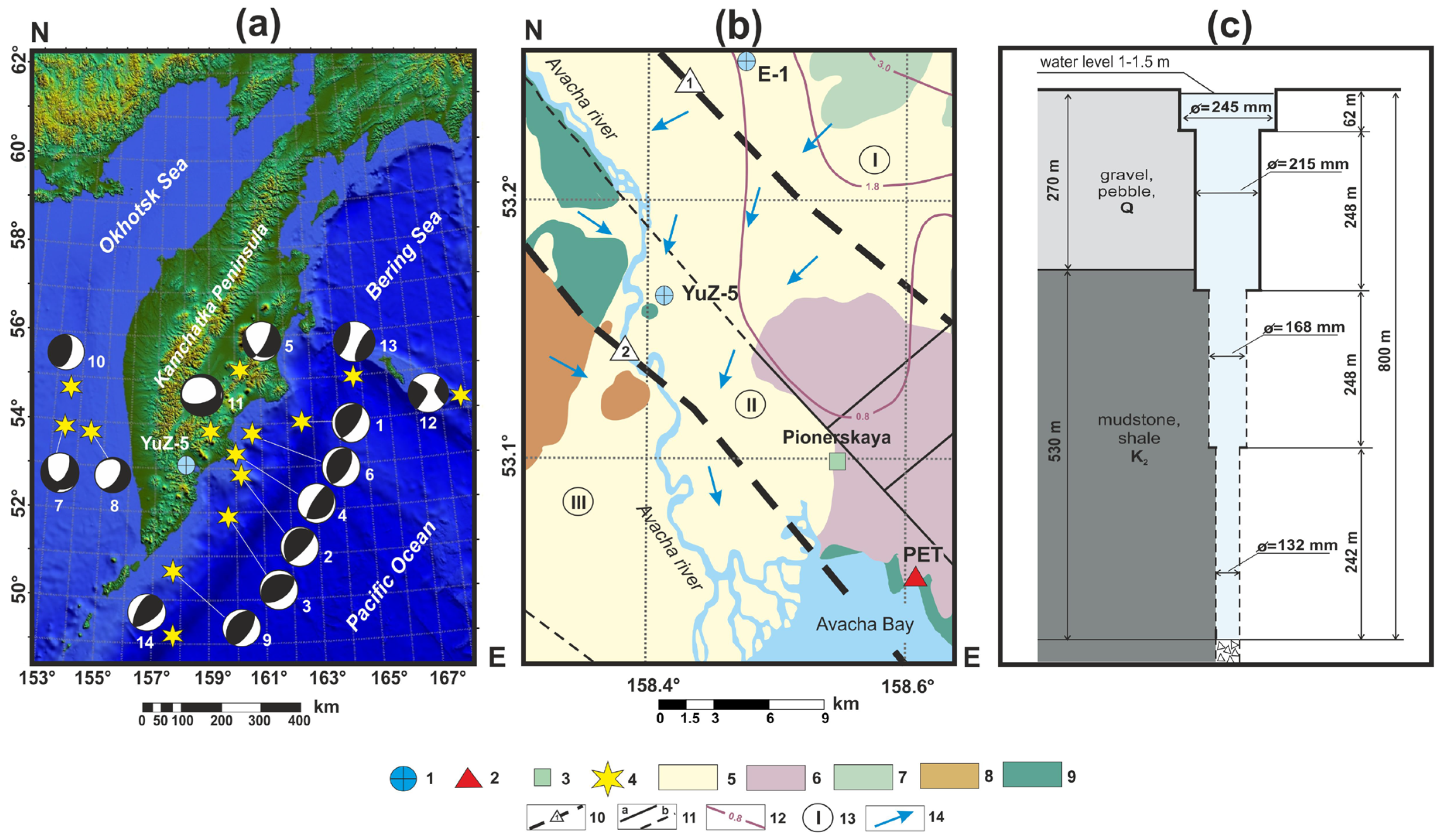
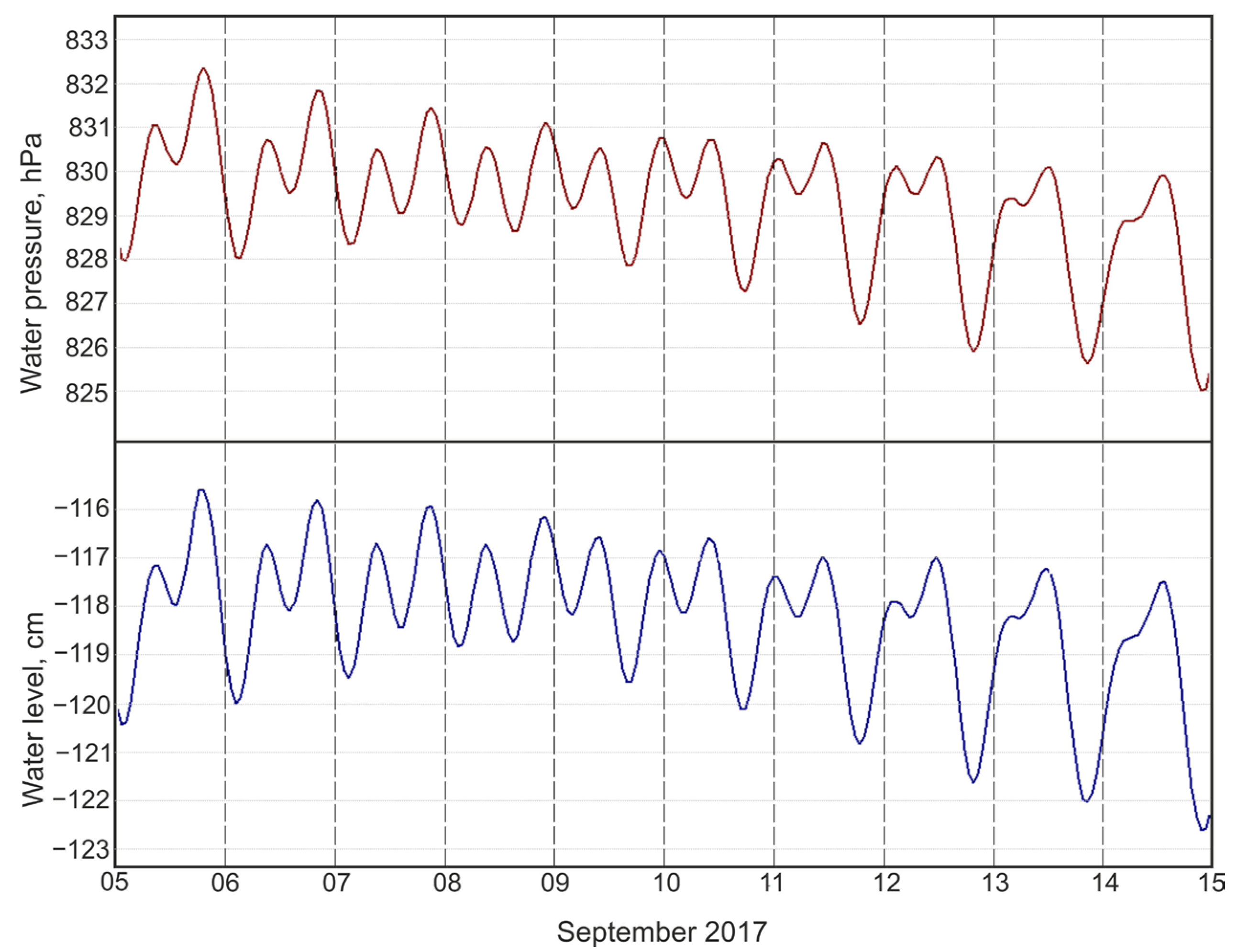
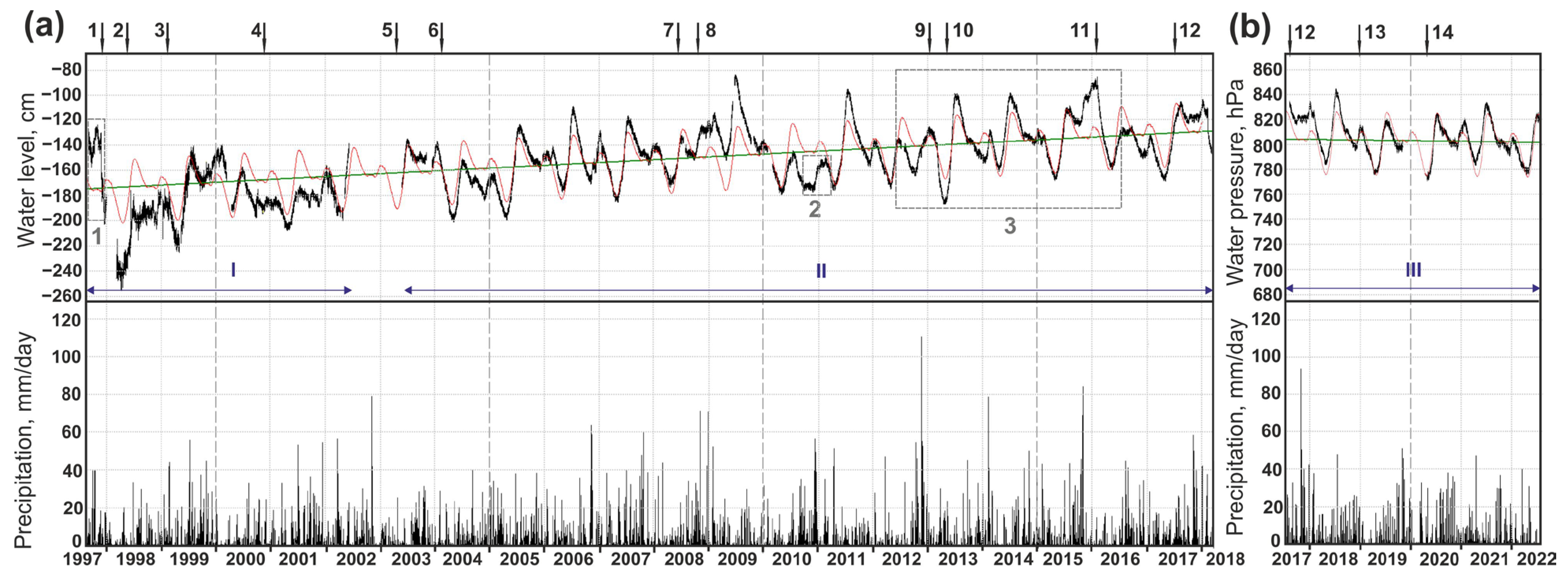


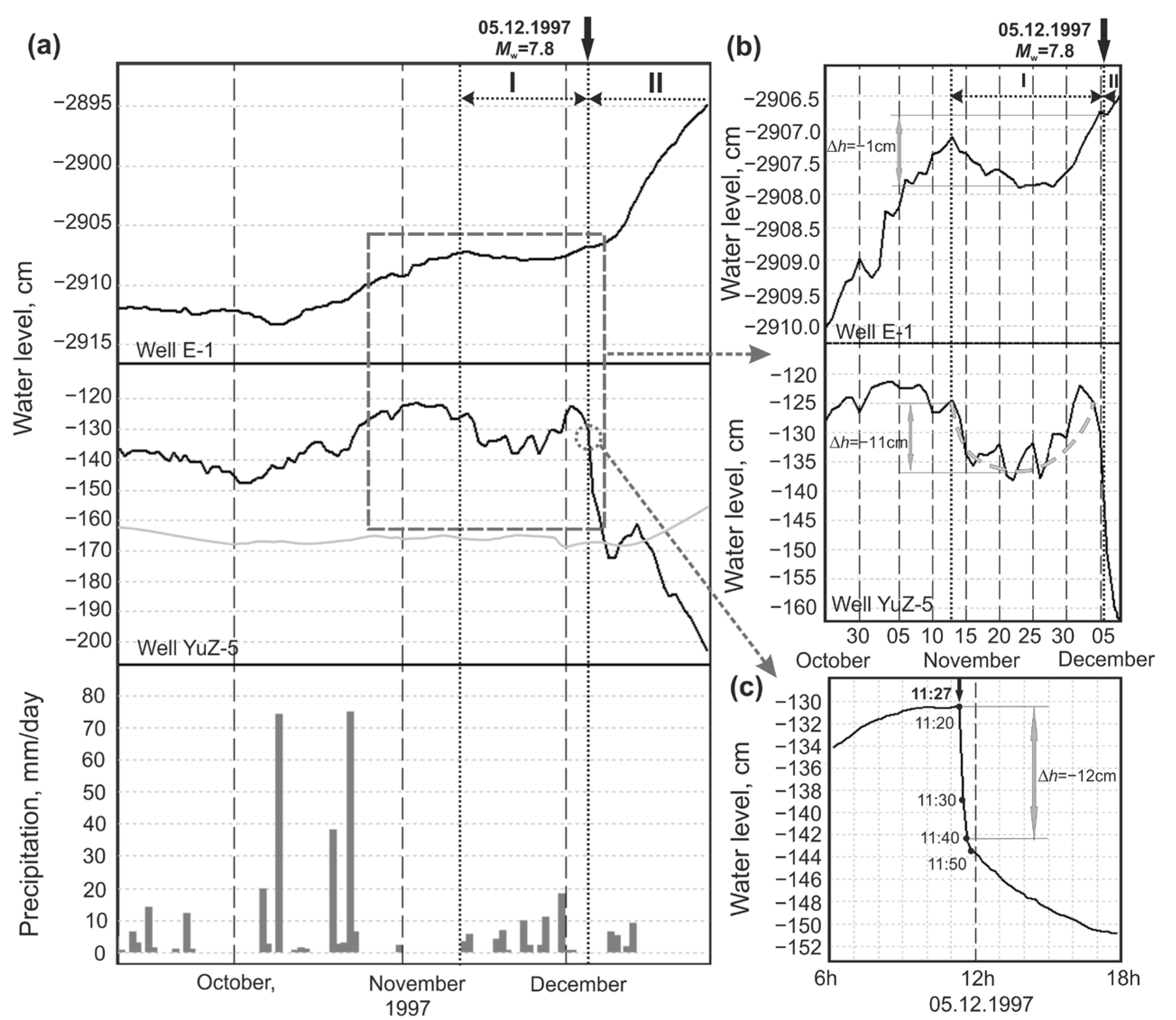

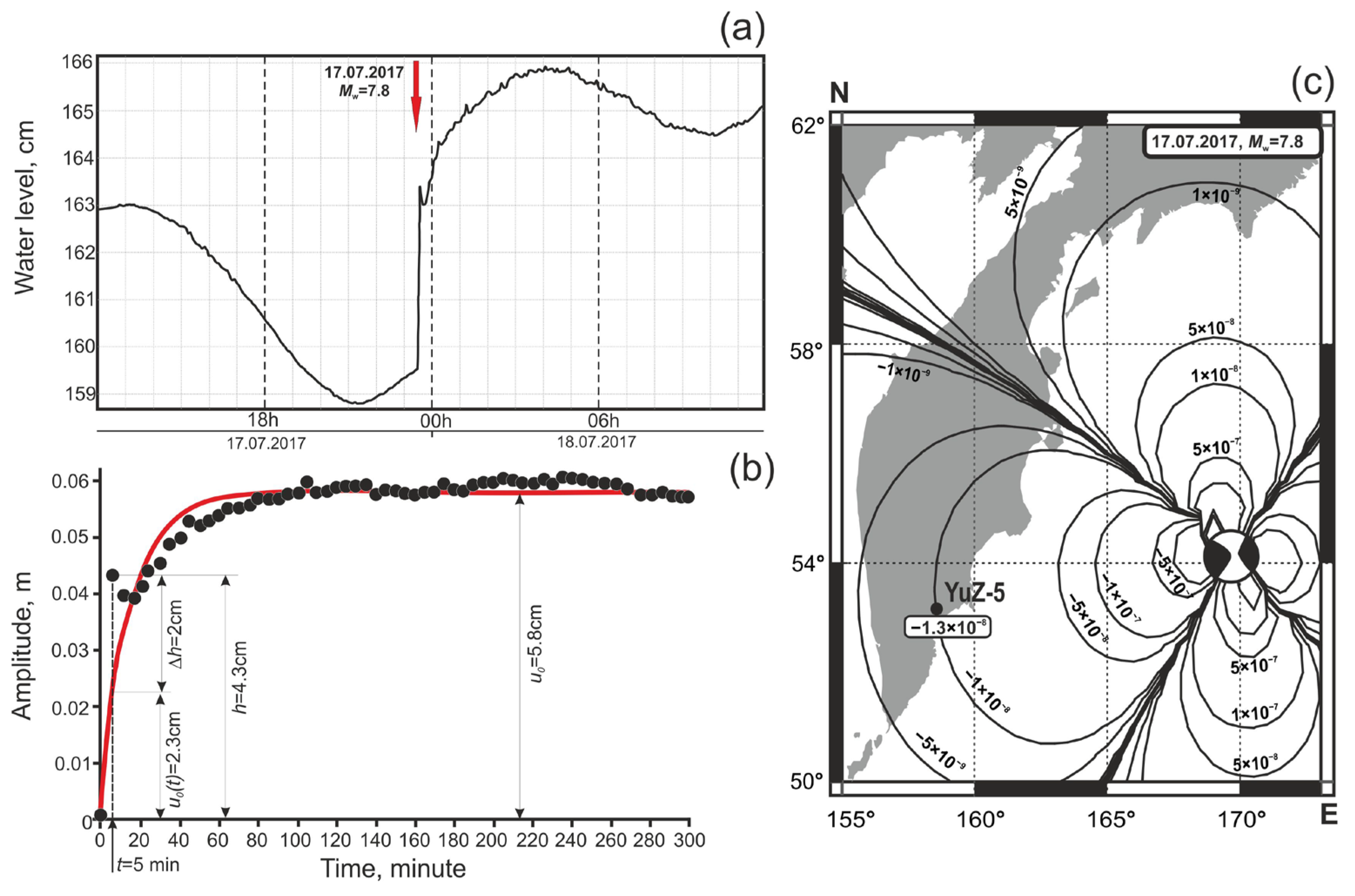
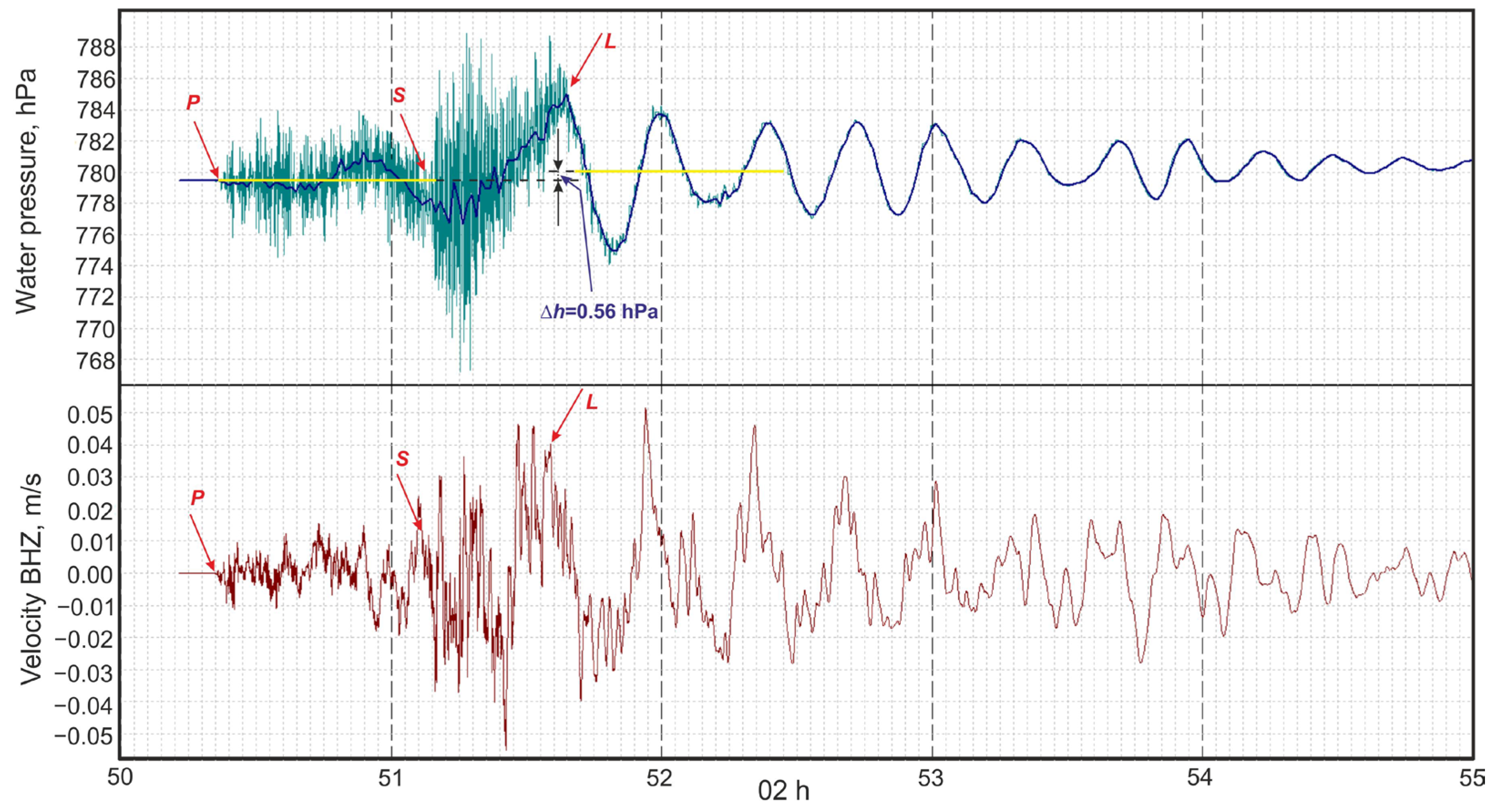

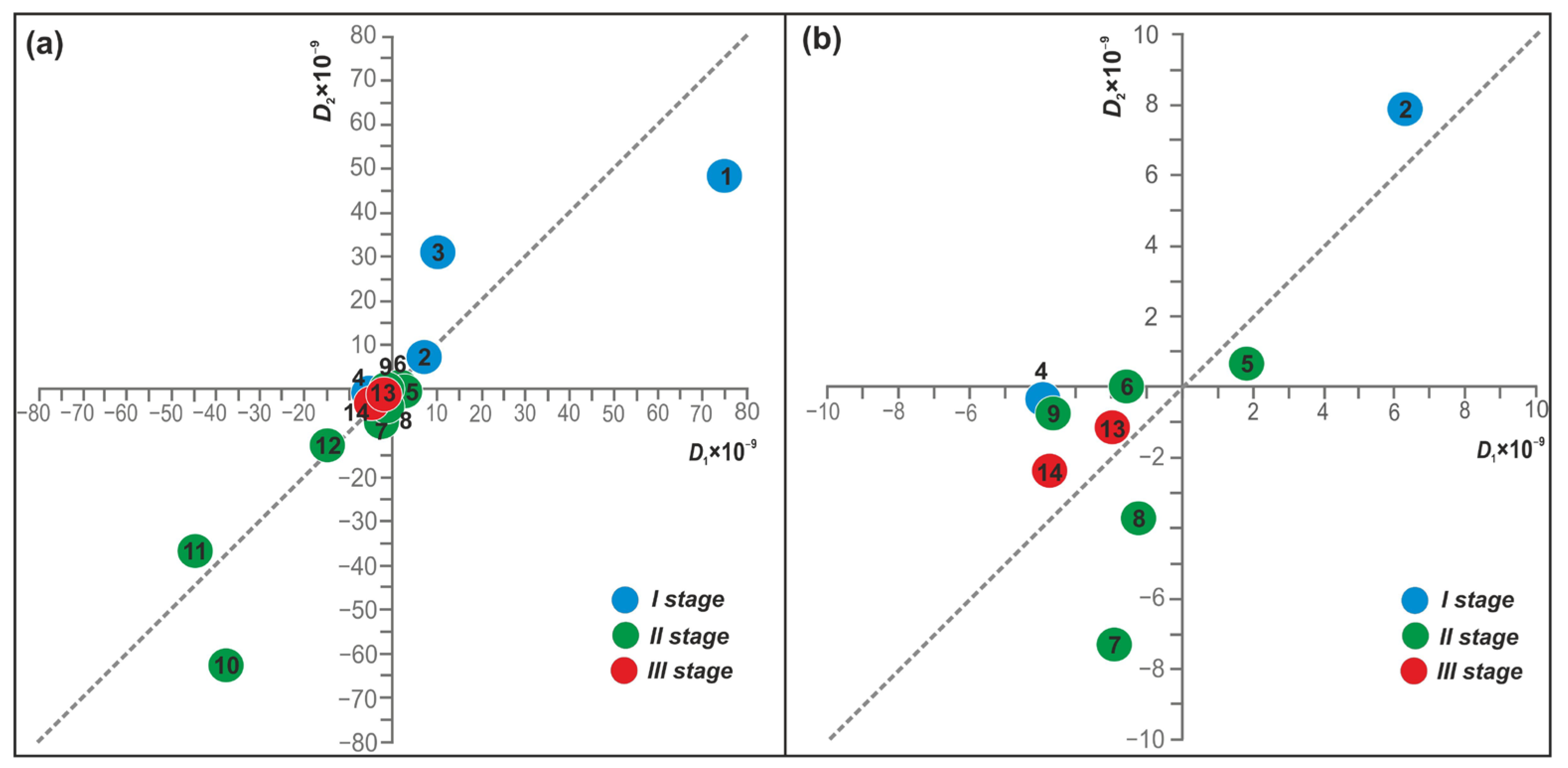
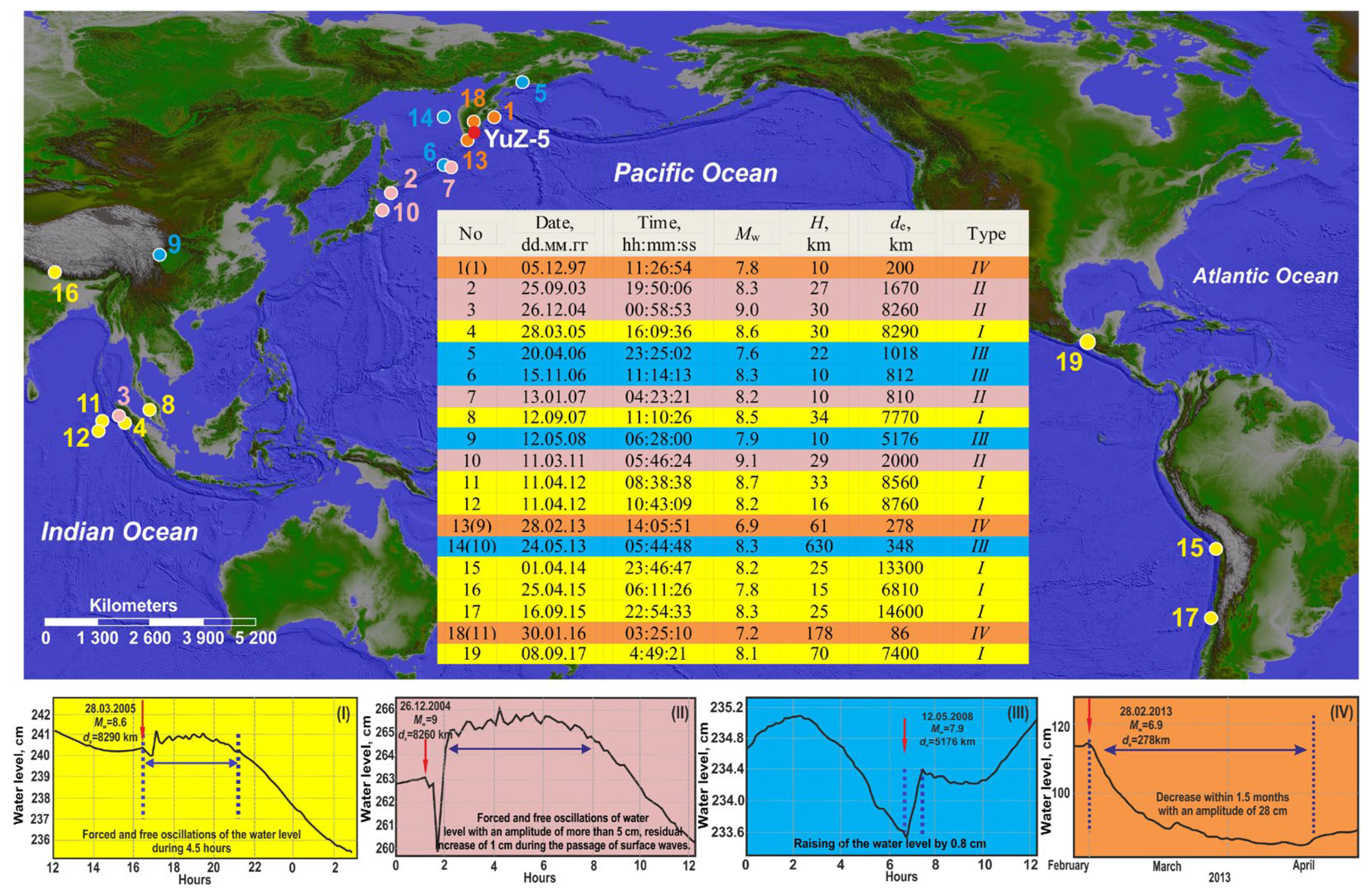
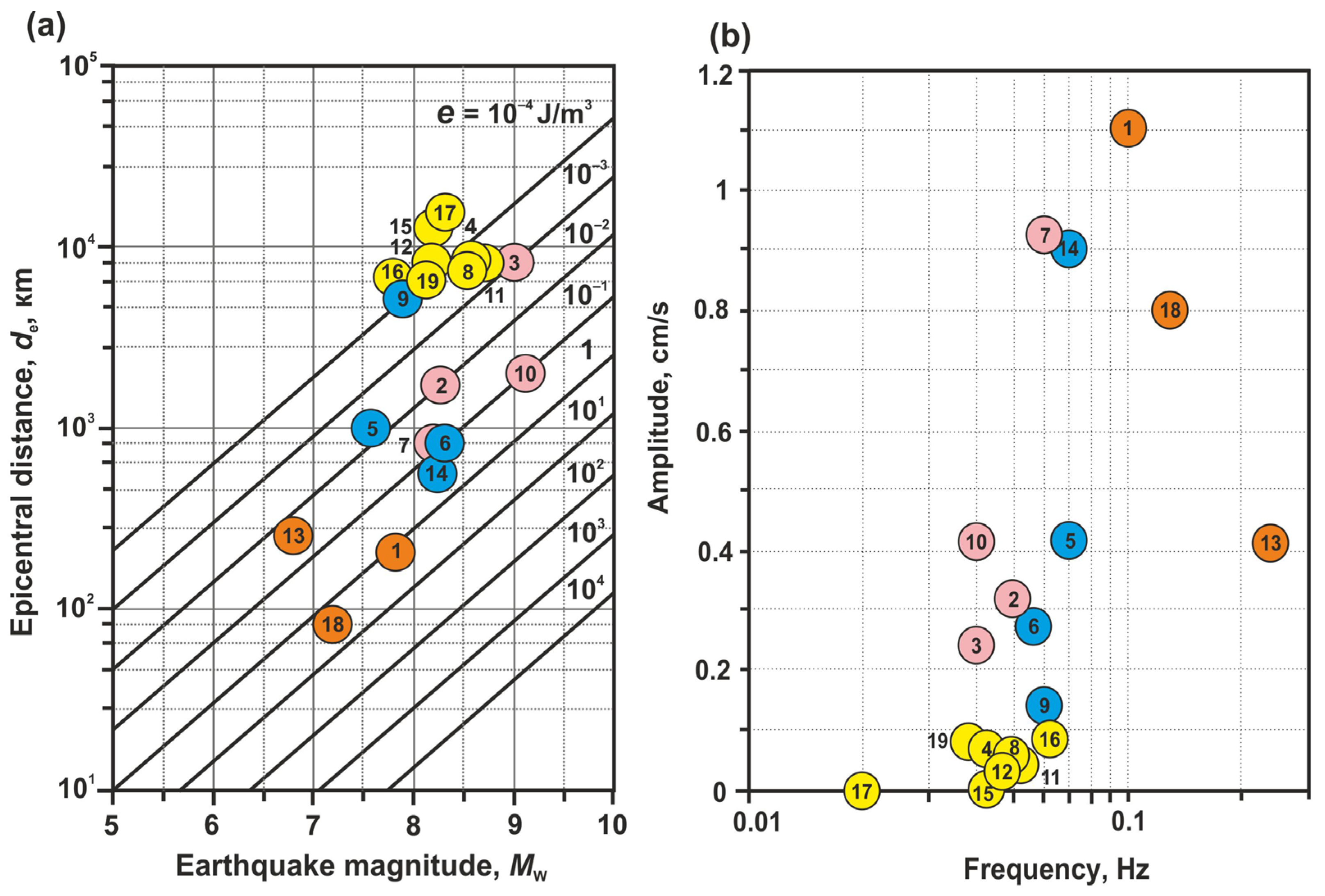

| Coor- dinates | Depth, m Open Interval, m | Lithology: Age, Composition | Water Level Depth, m | Water Temperature, °C | Water Mineralization, g/dm3 | Water Type | Gas Composition |
|---|---|---|---|---|---|---|---|
| 53.17°N 158.41°E | 800 310–800 | K2, mudstone, shale | 1.5 | 14 | 0.25 | HCO3–SO4– Na–Ca | dissolved gas, N2 |
| Observation Stages | Observation Period | Equipment | Registered Parameters | Measurement Accuracy | Measurement Frequency | References |
|---|---|---|---|---|---|---|
| I | Sep 1997–May 2003 | GIP-3 data logger, water level DU and atmospheric pressure DA sensors, Schmidt Institute of Physics of the Earth RAS, Moscow, Russia | water level, atmosphere pressure | 0.1 cm 0.1 hPa | 10 min | [25] |
| II | Jul 2003–Feb 2018 | Kedr A2 and Kedr DM data loggers with an ultrasonic water level sensor, Polinom LLC, Khabarovsk, Russia | water level, atmosphere pressure | 0.1 cm 0.1 hPa | 5–10 min | [26] |
| III | Aug 2017–Jul 2022 | CR6 and CR1000 data loggers, Campbell Scientific Inc, Logan, Utah, USA, and water pressure and temperature sensor PAA36XiW, Keller, Winterthur, Switzerland | water pressure atmosphere pressure | 0.002 hPa 0.1 hPa | 20 Hz 1 min | [27] |
| No. | Observation Period, Years | Time Series Length, Days/Years | Model Parameters | σmax, cm (hPa) | ||||
|---|---|---|---|---|---|---|---|---|
| Linear Trend | R2 * | Residuals | ||||||
| A, cm/Day (hPa/Day) | B, cm (hPa) | Average, cm (hPa) | Standard Error σ, cm (hPa) | |||||
| 1 | 1999–2001 | 1096/3 | −0.0065 cm/day | −175.6 | 0.45 | 1.5 × 10−7 cm | 12.1 cm | 30.9 cm/2.5 * |
| 2 | 2004–2008 | 1827/5 | 0.0167 cm/day | −170.2 | 0.76 | −3.7 × 10−7 cm | 8.9 cm | 22.9 cm/2.6 * |
| 3 | 2004–2017 | 5114/14 | 0.0062 cm/day | −160.8 | 0.58 | 5.1 × 10−8 cm | 13.8 cm | 44.6 cm/3.2 * |
| 4 | 2018–2021 | 1461/4 | −0.0037 hPa/day | 814.3 | 0.77 | 2.6 × 10−6 hPa | 7 hPa | 17.3 gPa/2.5 * |
Disclaimer/Publisher’s Note: The statements, opinions and data contained in all publications are solely those of the individual author(s) and contributor(s) and not of MDPI and/or the editor(s). MDPI and/or the editor(s) disclaim responsibility for any injury to people or property resulting from any ideas, methods, instructions or products referred to in the content. |
© 2023 by the authors. Licensee MDPI, Basel, Switzerland. This article is an open access article distributed under the terms and conditions of the Creative Commons Attribution (CC BY) license (https://creativecommons.org/licenses/by/4.0/).
Share and Cite
Kopylova, G.; Boldina, S. Seismo-Hydrogeodynamic Effects in Groundwater Pressure Changes: A Case Study of the YuZ-5 Well on the Kamchatka Peninsula. Water 2023, 15, 2174. https://doi.org/10.3390/w15122174
Kopylova G, Boldina S. Seismo-Hydrogeodynamic Effects in Groundwater Pressure Changes: A Case Study of the YuZ-5 Well on the Kamchatka Peninsula. Water. 2023; 15(12):2174. https://doi.org/10.3390/w15122174
Chicago/Turabian StyleKopylova, Galina, and Svetlana Boldina. 2023. "Seismo-Hydrogeodynamic Effects in Groundwater Pressure Changes: A Case Study of the YuZ-5 Well on the Kamchatka Peninsula" Water 15, no. 12: 2174. https://doi.org/10.3390/w15122174
APA StyleKopylova, G., & Boldina, S. (2023). Seismo-Hydrogeodynamic Effects in Groundwater Pressure Changes: A Case Study of the YuZ-5 Well on the Kamchatka Peninsula. Water, 15(12), 2174. https://doi.org/10.3390/w15122174







